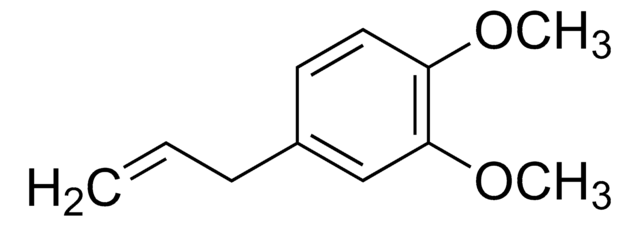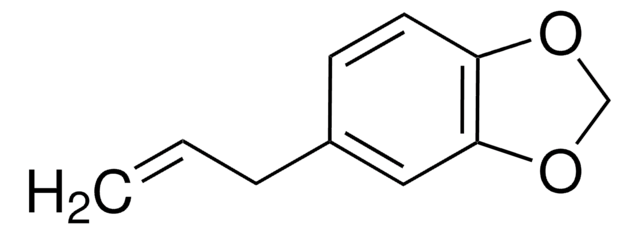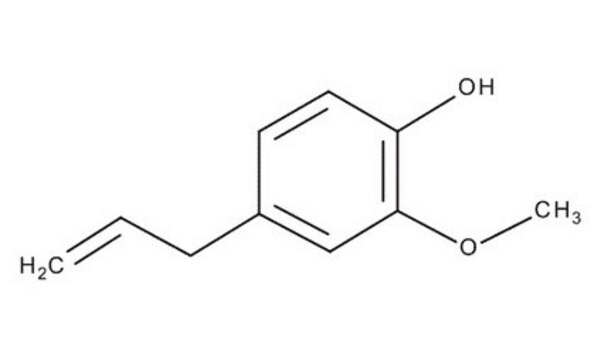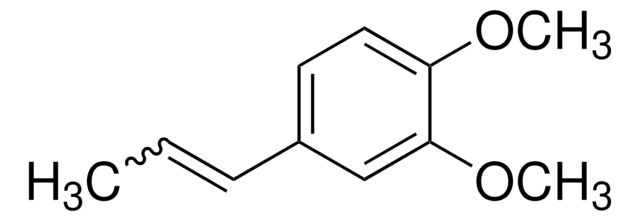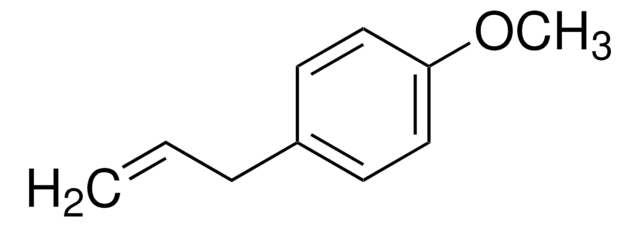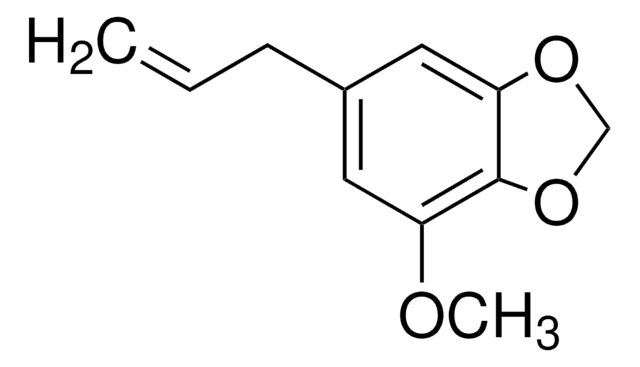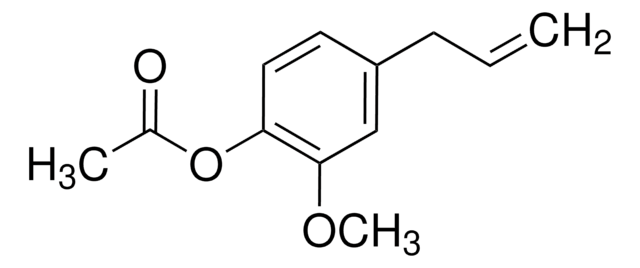W247502
Methyl eugenol
≥98%, FCC
Synonym(s):
Eugenol methyl ether, 4-Allyl-1,2-dimethoxybenzene, Eugenyl methyl ether
About This Item
Halal
Kosher
Recommended Products
biological source
synthetic
Quality Level
grade
Fragrance grade
Halal
Kosher
Agency
follows IFRA guidelines
reg. compliance
EU Regulation 1223/2009
FCC
Assay
≥98%
refractive index
n20/D 1.534 (lit.)
bp
254-255 °C (lit.)
mp
−4 °C (lit.)
density
1.036 g/mL at 25 °C (lit.)
application(s)
flavors and fragrances
Documentation
see Safety & Documentation for available documents
food allergen
no known allergens
fragrance allergen
eugenol
Organoleptic
cinnamon; clove; spicy; sweet; warm
SMILES string
COc1ccc(CC=C)cc1OC
InChI
1S/C11H14O2/c1-4-5-9-6-7-10(12-2)11(8-9)13-3/h4,6-8H,1,5H2,2-3H3
InChI key
ZYEMGPIYFIJGTP-UHFFFAOYSA-N
Looking for similar products? Visit Product Comparison Guide
Related Categories
General description
Application
- Development of broad-spectrum immunoassay with monoclonal antibody to detect five eugenols and study of their molecular recognition mechanism.: This article presents a new immunoassay using a monoclonal antibody designed to detect multiple eugenol derivatives including methyl eugenol, offering insights into their molecular interactions and potential applications in food safety and pharmaceutical analysis (Luo et al., 2024).
Biochem/physiol Actions
Other Notes
Disclaimer
Signal Word
Warning
Hazard Statements
Precautionary Statements
Hazard Classifications
Acute Tox. 4 Oral - Aquatic Chronic 2 - Carc. 2 - Muta. 2
Storage Class Code
10 - Combustible liquids
WGK
WGK 1
Flash Point(F)
230.0 °F - closed cup
Flash Point(C)
110 °C - closed cup
Personal Protective Equipment
Regulatory Listings
Regulatory Listings are mainly provided for chemical products. Only limited information can be provided here for non-chemical products. No entry means none of the components are listed. It is the user’s obligation to ensure the safe and legal use of the product.
PRTR
Class I Designated Chemical Substances
FSL
Group 4: Flammable liquids
Type 3 petroleums
Hazardous rank III
Water insoluble liquid
ISHL Indicated Name
Substances Subject to be Indicated Names
ISHL Notified Names
Substances Subject to be Notified Names
JAN Code
W247502-1KG-K:4548173969848
W247502-10KG-K:4548173969831
W247502-SAMPLE-K:
W247502-VAR-K:
W247502-25KG-K:4548173969855
W247502-25KG:
W247502-SAMPLE:
W247502-10KG:
W247502-BULK-K:
W247502-1KG:
Choose from one of the most recent versions:
Already Own This Product?
Find documentation for the products that you have recently purchased in the Document Library.
Customers Also Viewed
Global Trade Item Number
| SKU | GTIN |
|---|---|
| W247502-1KG | |
| W247502-1KG-K | 4061837861963 |
| W247502-25KG-K | 4061837861970 |
| W247502-SAMPLE | |
| W247502-10KG | |
| W247502-10KG-K | 4061837861956 |
| W247502-25KG | |
| W247502-SAMPLE-K | 4061837861987 |
Our team of scientists has experience in all areas of research including Life Science, Material Science, Chemical Synthesis, Chromatography, Analytical and many others.
Contact Technical Service